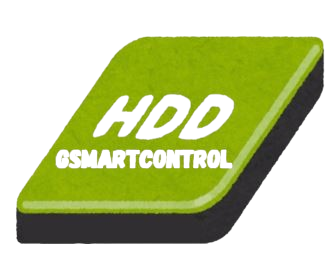GSmartControl
Monitor & Protect Your Hard Drives and SSDs
GSmartControl is a powerful yet user-friendly tool that lets you monitor the health of your hard drives and SSDs, run diagnostic tests, and access detailed reports. Protect your data and keep your drives performing at their best with ease.

How GSmartControl Works

Detect Drives
- Automatically identifies all connected hard drives and SSDs.
Check S.M.A.R.T. Attributes
- Reads key health metrics such as temperature, error rates, and reallocated sectors.
Run Tests
- Perform short, extended, or recurring self-tests to detect potential issues.
Analyze Results
- Highlight anomalies, warnings, or signs of drive failure for easy interpretation.
Key Features of GSmartControl
Self-Tests
Perform short, extended, or recurring diagnostics to detect issues early.
Drive Management
Enable or disable S.M.A.R.T., view detailed drive information, and save logs for later reference.
Cross-Platform Support
Works seamlessly on Windows, Linux, macOS, and FreeBSD.
Hardware Support
Compatible with SATA, PATA, NVMe drives, as well as some USB drives and RAID setups.
User-Friendly Interface
Intuitive design with clear visual indicators for easy monitoring
S.M.A.R.T. Monitoring
Track drive temperature, errors, and performance metrics in real-time.
Download and Install GSmartControl

Windows: Download the precompiled installer for fast setup.
Linux: Install via your package manager (apt, yum) or download directly from the website.
macOS & FreeBSD: Available through MacPorts, Fink, or other package managers.
Download from GSmartcontrol.com
Installation Steps
- Download the appropriate version for your operating system.
- Install the program following the on-screen instructions.
- Launch GSmartControl and start monitoring your drives immediately.
Why Choose GSmartControl?
| Feature | GSmartControl | Other Tools |
|---|---|---|
| S.M.A.R.T. Monitoring | ✅ Full-featured | ✅ Basic |
| Run Self-Tests | ✅ Short, Extended, Recurring | ❌ Limited |
| Cross-Platform | ✅ Windows, Linux, macOS, FreeBSD | ❌ Commercial |
| Open Source | ✅ Free & Open Source | ❌ Freeware |
| Error Logging | ✅ Detailed logs & save options | ❌ Basic |
| Drive Management | ✅ Enable/Disable S.M.A.R.T., configure options | ❌ Limited |
Common Use Cases & Limitations of GSmartControl
Common Use Cases
- Personal Users: Monitor laptops and desktops to protect personal data.
- Small Businesses: Keep multiple PCs and NAS drives healthy.
- Enterprise IT / Servers: Proactively maintain servers and storage systems.
- Data Recovery Professionals: Assess drive integrity before recovery attempts.
- Tech Enthusiasts: Benchmark performance and monitor multiple drives over time.
Limitations
- RAID/USB Limits: Some RAID setups or USB adapters may not provide full S.M.A.R.T. data, reducing monitoring accuracy.
- Cannot Repair Bad Sectors: GSmartControl detects issues but cannot fix physical damage.
- M.A.R.T. Not Fully Predictive: Drives can fail even if all attributes appear normal; backups are still needed.
- Admin Privileges Required: Some tests need administrative or root access to run.
Troubleshooting GSmartControl

Drive Not Detected
- Ensure the drive is connected and powered.
- Run GSmartControl as administrator/root.
- Some RAID setups or USB drives may require manual configuration.
Self-Tests Not Running
- Close other programs that may be accessing the drive.
- Try running short and extended tests separately.
- Ensure the drive supports S.M.A.R.T. self-tests.
Missing S.M.A.R.T. Data
- Connect the drive via SATA, NVMe, or PATA.
- Update the drive firmware if available.
- Some external USB adapters may not provide full data.
Frequently Asked Questions (FAQs)
What is GSmartControl?
It’s an open-source utility for checking the health of hard drives and SSDs using S.M.A.R.T. data, running diagnostics, and generating reports.
Does it cost anything?
No. GSmartControl is completely free and open source.
Which operating systems are supported?
No. GSmartControl is completely free and open source.
What drive types can it monitor?
SATA, PATA, NVMe, plus some USB-connected drives and RAID setups.
Can it fix a failing drive?
No. It only detects problems—it cannot repair physical damage or recover data.
What is S.M.A.R.T. monitoring?
It’s a system built into drives that tracks metrics like temperature, error rates, and reallocated sectors to gauge health.
Do I need administrator rights?
Yes, certain tests and log-saving options require admin/root access.
Can it warn me before a drive fails?
It can highlight risks, but no tool can guarantee prediction. Regular backups remain essential.
How do I install it on Windows?
Download the official installer and follow the setup wizard.
How do I install it on Linux?
Use your package manager (e.g., apt install gsmartcontrol) or grab it directly from the site.
How about macOS?
Install via MacPorts, Fink, or another package manager.
What tests are available?
Short, extended, and scheduled recurring self-tests.
How long does testing take?
A short test runs in minutes; an extended test can take hours depending on drive size.
My logs won’t save. What should I do?
Choose a folder with write access and run GSmartControl as administrator/root.
Can it monitor multiple drives at once?
Yes, all connected drives are detected automatically.
Will it work with external USB drives?
Sometimes. Many adapters don’t pass through full S.M.A.R.T. data.
Can I turn off S.M.A.R.T.?
Yes, the program lets you enable or disable S.M.A.R.T. features.
Who uses GSmartControl?
Everyone from home users to IT staff, server admins, and data recovery professionals.
Does running a test slow down the computer?
Short tests usually don’t. Extended tests may reduce performance until they finish.
What sets GSmartControl apart from other tools?
It’s cross-platform, detailed, open source, and more feature-rich than many freeware alternatives.